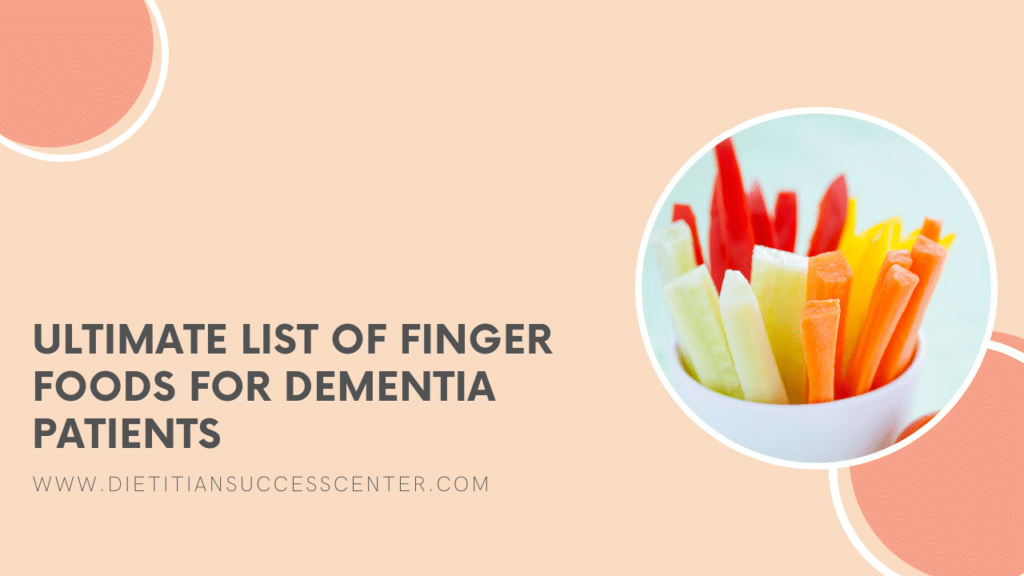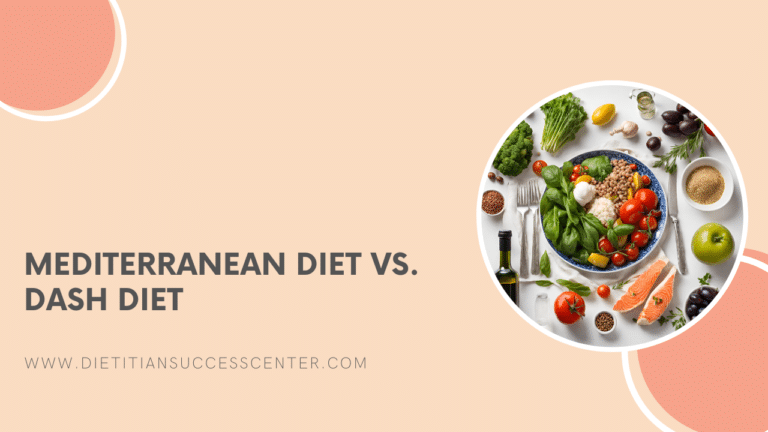
Written by Emily Persaud, Dietetic Intern
Reviewed by Krista Kolodziejzyk, RD, MPH, MBA & Olivia Farrow, RD, MHSc
Good nutrition provides energy and nutrients that support growth and aging. People living with dementia may forget how to use utensils and/or may be opposed to feeding assistance. Many meals can be eaten without, or modified to be eaten without utensils. In this article, we share an extensive list of finger foods for dementia patients.
Why Finger Foods?
Patients with dementia may experience a loss of coordination, which may make it difficult to hold utensils.
Finger foods (ie. foods that can be eaten without utensils) can be easier for dementia patients to handle, allowing them to potentially eat more and decrease their risk of malnutrition (1,2). In addition, during mealtimes, finger foods can help patients with dementia maintain their dignity and independence, contributing to quality of life (1,2). According to one study, 70% of dementia patients had increased food intake and weight gain when cutlery was not used (3).
Below, you will find a list of finger foods for dementia patients. Please note that all items listed below may not be appropriate for all dietary needs and conditions. Keep in mind that people with chewing and swallowing difficulties may require further modifications.
Learn more about texture modifications in DSC’s Dysphagia toolkit & video course or Nutrition for Older Adults & LTC toolkit & video course.
List of Finger Foods for Dementia Patients
Breakfast
-
- Cereal, yogurt, or granola bars. High-calorie and nutrient-dense bars can be a great way to meet a patient’s nutrient targets.
-
- Sandwiches and bagels. Sandwich toppings can be mixed with mayonnaise, cheese, and other spreads to make them stick to the bread and increase caloric density. Add:
-
- Deli meats
-
- Cheese
-
- Cream cheese
-
- Jam
-
- Peanut butter
-
- Egg
-
- Tuna
-
- Sandwiches and bagels. Sandwich toppings can be mixed with mayonnaise, cheese, and other spreads to make them stick to the bread and increase caloric density. Add:
-
- Baked goods are an easy option for handheld foods. Choose options that won’t fall apart while eating, like:
-
- English muffins
-
- Tea cakes
-
- Scones (fresh; stale scones tend to crumble easier)
-
- Croissants
-
- Crumpets
-
- Muffins
-
- Fruit bread
-
- Banana bread
-
- Baked goods are an easy option for handheld foods. Choose options that won’t fall apart while eating, like:
-
- Pancakes or waffles. Provide maple syrup as a dip rather than pouring it over to avoid sticky fingers.
-
- Mini sausages. Serve mini sausages or cut sausages up into bite-sized pieces.
-
- Boiled eggs. Cut them into quarters or slice them. Eggs are a great way to add protein to a patient’s diet.
-
- Tubed yogurt. Tubed yogurt is convenient and fun! Yogurt is a great way to add protein, calcium, and vitamin D to a patient’s diet.
-
- Biscuits and crackers. Add dips to boost the nutritional content of the patient’s meal. Dips could include:
-
- Hummus
-
- Cheese sauce
-
- Salsa
-
- Dill
-
- Guacamole
-
- Biscuits and crackers. Add dips to boost the nutritional content of the patient’s meal. Dips could include:
-
- Cheese cubes/slices, or string cheese. Cheese can be added to a lot of meals or eaten as-is!
Lunch / Dinner
-
- Chicken strips, nuggets, or legs. Choose grilled or baked options whenever possible, instead of fried. Serve with a dip:
-
- Sweet and sour
-
- Honey mustard
-
- Ranch
-
- Hot sauce
-
- Gravy
-
- Chicken strips, nuggets, or legs. Choose grilled or baked options whenever possible, instead of fried. Serve with a dip:
-
- Cut-up meat. Cut meat into bite-sized pieces that can be eaten with the hands. Choose moist meats as dry meat may be more difficult to eat.
-
- Meatballs, patties, and kebabs. These can be made with:
-
- Tuna
-
- Salmon
-
- Shrimp
-
- Chicken
-
- Beef
-
- Pork
-
- Plant-based proteins (ex. Chickpeas, beans, lentils, tofu, etc.)
-
- Meatballs, patties, and kebabs. These can be made with:
-
- Quiche or frittata. Mini versions are easy to hold and fun to eat. Add any meat, cheese, spices, and vegetables.
-
- Pizza slice. Toppings are a great way to pack some extra calories and vitamins into a meal. Vegetable toppings could include:
-
- Tomatoes
-
- Peppers
-
- Onion
-
- Broccoli
-
- Kale
-
- Eggplant
-
- Olives
-
- Mushrooms
-
- Tofu
-
- Ham
-
- Pepperoni
-
- Chicken
-
- Pizza slice. Toppings are a great way to pack some extra calories and vitamins into a meal. Vegetable toppings could include:
-
- Sushi. Pair with low-sodium soy sauce, wasabi, and ginger.
-
- Bread.
-
- Dinner rolls
-
- Wraps
-
- Quesadillas
-
- Breadsticks
-
- Burrito
-
- Burgers
-
- Sandwiches
-
- Bread.
-
- Fries, wedges, and cut-up potatoes. Serve with dips to boost the flavor and calories as-needed.
-
- Noodles or pasta. Ensure you are choosing a type of noodle that is large enough to pick up with fingers. Instead of serving with a sauce on top, serve the sauce as a dip.
-
- Drained and dried beans. This is a great way to increase the protein, fiber, and carbohydrates in a patient’s diet. Popular choices include:
-
- Black beans
-
- Chickpeas
-
- Kidney beans
-
- Navy beans
-
- Drained and dried beans. This is a great way to increase the protein, fiber, and carbohydrates in a patient’s diet. Popular choices include:
-
- Egg rolls, spring rolls, fish/crab cakes, and samosas. These are great as an appetizer, snack, side, or a meal. Pair it with:
-
- Sweet and sour sauce
-
- Sweet chili
-
- Peanut sauce
-
- Tartare sauce
-
- Chutney
-
- Egg rolls, spring rolls, fish/crab cakes, and samosas. These are great as an appetizer, snack, side, or a meal. Pair it with:
Dessert / Snack
-
- Cookies and brownies.
-
- Cake. Who doesn’t love cake? Serve a mini cheesecake, or a slice of the patient’s favorite cake.
-
- Tarts, donuts, and cinnamon rolls. Add some whipped cream as a dip for some extra fun and calories.
-
- Ice cream. Ice cream bars, cones, and sandwiches are great for a hot day.
-
- Chocolate. Mini assorted chocolate bars are a convenient and simple dessert option.
Fruits & Vegetables
Fruits and vegetables have vitamins and antioxidants that are beneficial to add to a dementia patient’s diet. Try these tips to make eating fruit and vegetables easier for dementia patients:
-
- Cut whole fruits and vegetables into bite-sized portions, slices or strips. .
-
- Serve raw vegetables with a dip.
-
- Ranch
-
- Hummus
-
- Guacamole
-
- Serve raw vegetables with a dip.
-
- Serve miniature versions of vegetables if possible.
-
- Baby carrots (may need to be cooked soft or cut in quarters lengthwise if there is a choking risk)
-
- Baby potatoes
-
- Baby cucumbers
-
- Baby peppers
-
- Serve miniature versions of vegetables if possible.
-
- Serve fresh fruits with the peel on. When edible, the peel can make it easier to grip the fruit.
Try these fruit and vegetable ideas:
-
- Dried fruit
-
- Dates
-
- Apricots
-
- Raisins
-
- Peaches
-
- Dried fruit
-
- Mushrooms
-
- Sliced or quarter tomatoes
-
- Pineapple chunks
-
- Berries
-
- Banana slices, or a whole banana (peeled)
-
- Peach slices
-
- Tangerine or orange sections
-
- Baby carrots
-
- Cooked, steamed or baked vegetables
-
- Sweet potato
-
- Carrot
-
- Cauliflower florets
-
- Broccoli florets
-
- Cooked, steamed or baked vegetables
-
- Cut-up or halved melon, kiwi and strawberries
-
- Apple, pear and peach (with peel)
-
- Cucumber slices
-
- Green beans
-
- Salad (with dip)
-
- Celery sticks (with dip)
-
- Watermelon sticks
Key Takeaways
Nutritional concerns are very common for people with dementia. Finger foods have been demonstrated to increase food intake and independence among dementia patients (3). As a result, nutritional status and overall quality of life can be improved as well.
Many foods can be modified to be finger foods — get creative! Serve calorie-dense foods, such as dips, sauces and spreads, to increase the nutrient content of the meal. Mix and match the ideas above to make the most out of mealtimes with dementia patients.
Disclaimer: the information provided in all written materials is for educational purposes only and is not to be used as medical advice or to diagnose or treat a medical disease. It is strictly for informational purposes and is general in nature. Dietitian Success Center Inc. is not responsible and cannot be held liable for any actions or inactions taken related to the information provided. Consult with your local medical provider before implementing any dietary changes. It is hereby understood that the information provided does not replace medical advice provided by your healthcare provider.
Dietitian Success Center is THE professional development resource for dietitians and dietetic students. Our mission is to make it easier for dietitians and dietetic students to build expertise. We do this through evidence-based online nutrition courses, community and ready-to-use client handouts. Plus – we give you the tools to start and grow your dietitian private practice!
References
- Pouyet, Virginie, Agnes Giboreau, and Gerard Cuvelier. “Attractiveness and consumption of finger foods in elderly Alzheimer’s disease patients.” Food Quality and Preference, vol. 34, no. 2, 2014, pp. 62-69. https://doi.org/10.1016/j/foodqual.2013.12.011
- “High Calorie Finger Foods.” Blackpool Teaching Hospitals NHS Foundation Trust. 16 May. 2017, https://www.bfwh.nhs.uk/wp-content/uploads/2016/12/High-Calorie-Finger-foods-created-16.05.2017.pdf
- Ford, Ginger. “Putting Feeding Back Into the Hands of Patients.” Journal of Psychosocial Nursing and Mental Health Services, vol. 34, no. 5, 1996, pp. 35-39.
- “List of Finger Foods for Dementia Patients.” Dementia Nutrition Solutions. 2022, https://dementianutrition.com/list-of-finger-foods-for-dementia/








